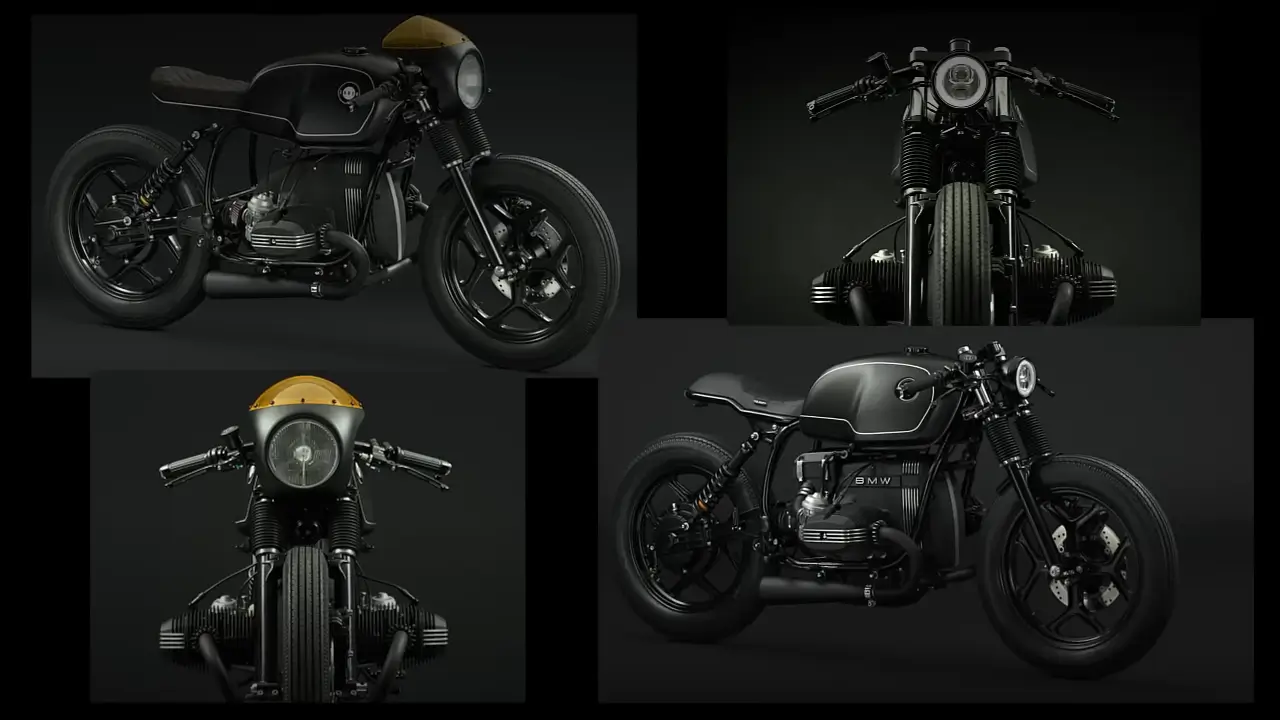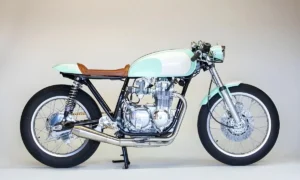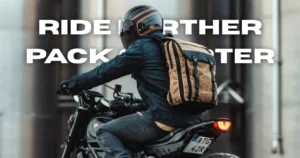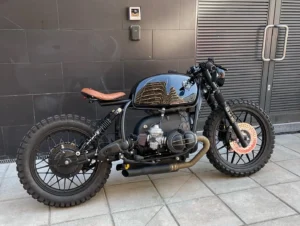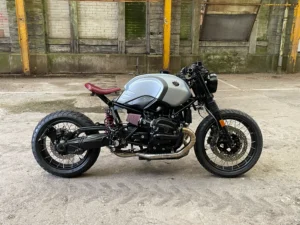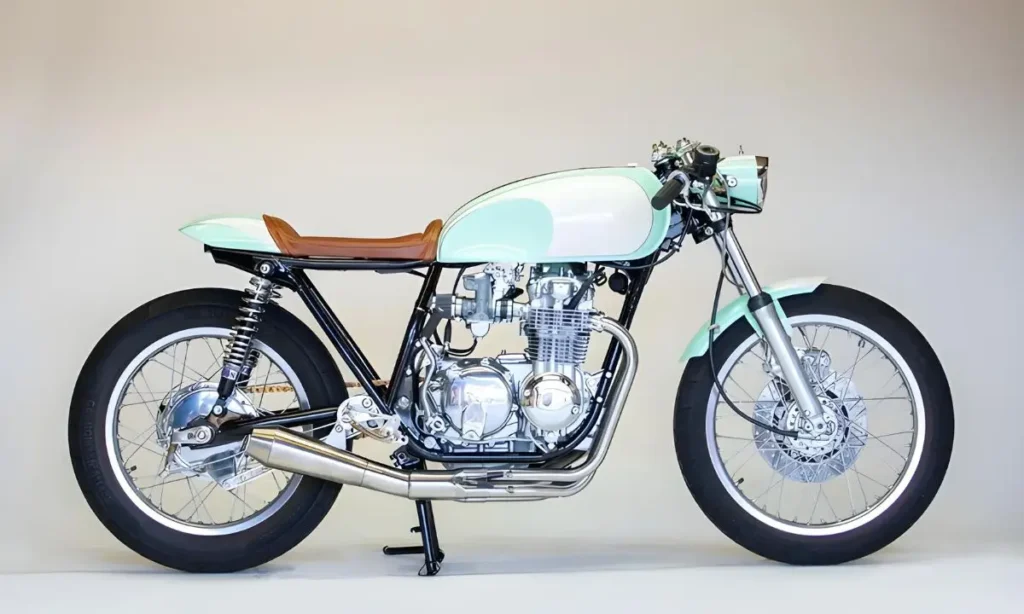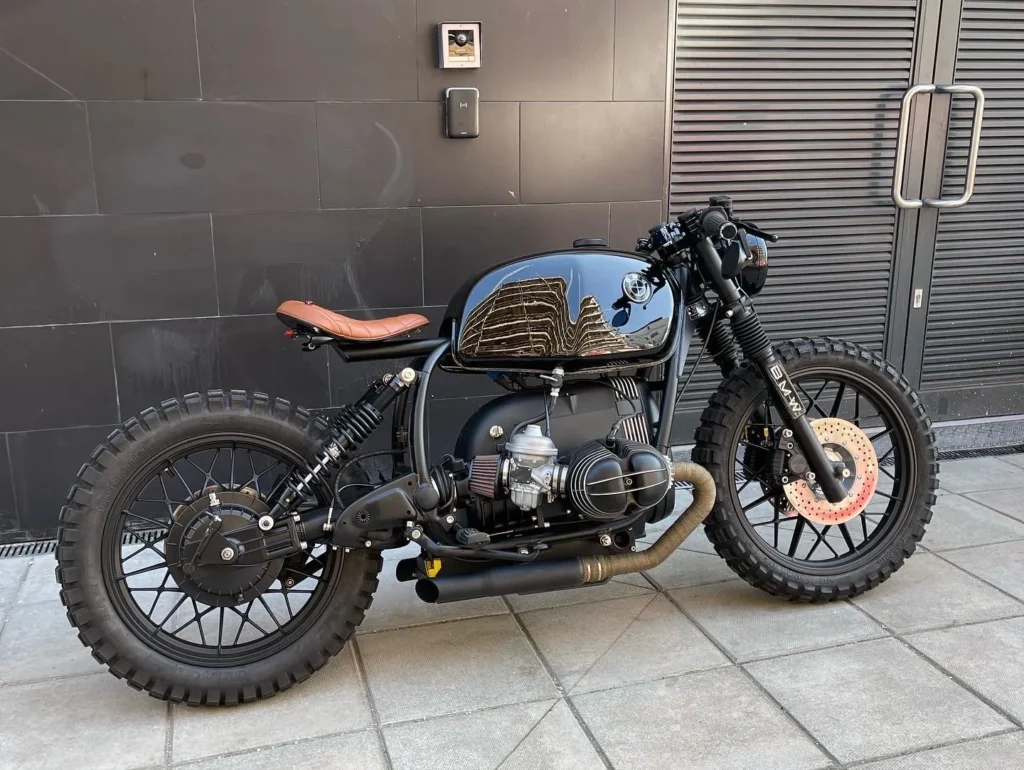BMW cafe racers are custom fast bikes from the 1960s. Riders made them lighter and faster to race between cafés. A BMW café racer is more than a bike; it’s a symbol of speed, style, and rebellion. Turning a BMW into a cafe racer means mixing old designs with new technology. This guide is for motorcycle fans who love customizing. It helps you create a BMW café racer that matches your style and honors the café racer tradition.

Table of Contents
ToggleDefinition and Origin of BMW Cafe Racers
BMW cafe racers are more than just bikes; they are symbols of culture and history. They focus on a sleek look and high speed. After World War II in Britain, ‘cafe racer’ described fast motorcycles modified for quick rides between cafes. The subculture valued simple design. Riders removed extra parts to make the bikes lighter and faster. Many chose BMW motorcycles for these changes. BMWs were reliable and had unique boxer engines. Their great engineering made them a popular choice. Riders liked BMWs for their strong build. The engines gave their cafe racers a cool look. These bikes mix classic style with power. BMW café racers blend old and new styles, showing individuality and honoring a rebellious, speed-loving era.
Historical Background of BMW Cafe Racers
The story of BMW cafe racers is closely linked to motorcycle history. After World War II, engineering skills and a rebellious lifestyle came together. In the 1950s and 1960s, Europe was recovering and changing. This time sparked the cafe racer movement, known for its speed, freedom, and unique style. BMW has been making motorcycles since the early 1900s. Its bikes became a key part of this new trend.
Let’s watch a video to know about the history of the BMW Motorcycle
Cafe racers love BMW motorcycles. These bikes are known for their reliable performance and special boxer engines. The R Series is perfect for customizing. It’s strong and has a distinct look. Riders are drawn to these bikes. They can handle high speeds and match the minimalist cafe racer style. This time was crucial for BMW. The brand became a big part of motorcycle culture, blending engineering with the spirit of rebellion and freedom.
Popularity and Evolution of BMW Cafe Racers
BMW cafe racers are very popular and are changing the motorcycle world. After the war, people wanted bikes that were fast and simple. Now, these bikes are famous for their looks and speed. BMW cafe racers began in London in the 1960s and are still popular today. People love them for their classic design and cool mechanics.
BMW cafe racers are great because they can do many things. BMW is known for making strong engines. The brand focuses on being accurate and reliable. Its unique boxer engines are perfect for customizing. Fans of BMW love these features. They see the chance to create something personal and special.
The cafe racer scene has changed over time. This is due to better technology and materials. Modern BMW cafe racers show this progress. They mix new technology with a vintage look. Fuel injection, digital displays, and performance upgrades blend with retro designs. This creates bikes that honor the past while looking to the future.
A lively community of riders and builders keeps this trend alive. Online forums, social media, and meet-ups are where people gather. They share ideas, find inspiration, and enjoy the cafe racer culture. This shows the strong spirit of the movement. The BMW cafe racer isn’t just a bike—it’s a lifestyle.
The popularity of the BMW cafe racer reflects broader changes in motorcycle culture. It blends history with new ideas. These bikes aren’t just about speed or style. They are a way to express yourself, connect with tradition, and explore what a motorcycle can be.
Overview of BMW Motorcycles

BMW Motorrad, part of the BMW Group, makes high-quality motorcycles. Since 1923, BMW Motorrad has been a leader in motorcycle design. It is known for its quality, performance, and reliability. Their motorcycles are famous for their unique boxer engines. They also use advanced engineering and new technology. This makes them popular with both everyday riders and motorcycle fans. BMW focuses on safety, comfort, and performance in every motorcycle. BMW motorcycles have a special style and design. They stand for passion, lifestyle, and freedom on the open road.
Key BMW Cafe Racer Models
BMW R-Series

The BMW R Series Cafe Racer bikes are loved by riders who like motorcycles with classic looks and modern technology. This line includes cool models like the BMW R nineT, which is easy to customize and has a retro style. The BMW R1200CS is sporty but still has a vintage feel. The BMW R100 is strong, reliable, and has a timeless look. The more modern BMW R1100R uses advanced technology but still feels classic.
Two famous bikes in this series are the BMW R80 and BMW R65. The BMW R80 is loved for its mix of power and ease. It’s a top choice for cafe racer fans. It’s known for being reliable and easy to change, blending new technology with a classic look. The BMW R65 is different. It’s smaller and lighter, with a simple design. It’s great for riders who like a smooth, easy ride. Even with its small engine, the R65 still feels like a true BMW with its unique style and handling.
Each bike in this series is special, but they’re all well-made. They’re perfect for riders who enjoy both old and new styles. These bikes have a long history, starting in the 1920s when the first BMW motorcycle was built. Over time, the R Series has brought new ideas while keeping classic designs.
One feature that sets these bikes apart is the boxer engine. This engine design places the cylinders sideways. This makes the bike easier to handle, especially on curvy roads. The boxer engine also provides a smooth ride and a unique sound, which adds to the fun of riding.
Besides the engine, each bike in the BMW R Series Cafe Racer line includes modern technology. These bikes have features like ABS brakes to prevent crashes, traction control to grip the road, and electronic suspension for a smoother ride. Some models even offer heated grips and cruise control for extra comfort.
Whether you’re new to motorcycles or a seasoned rider, the BMW R Series Cafe Racer line has something for everyone. With a mix of classic style, modern tech, and reliable performance, these bikes are a joy to ride.
BMW K-Series

The BMW K Series Café Racer is ideal for riders who want a cool and powerful motorcycle. This line of bikes is known for being well-built and reliable. It includes models like the K75, K100, K1100, and K1200. Each model is unique, making it perfect for creating a one-of-a-kind café racer.
The K75 has a three-cylinder engine, making it light and easy to handle. The K100, called the “Flying Brick,” has a strong four-cylinder engine and is a great starting point for custom work. The K1100 and K1200 are even more powerful, with newer features, making them a top choice for a fast café racer that also looks great.
Whether you’re working on a K75 or a K1200, there are many ways to make it your own. It’s not just about the engine or speed. The café racer style, with its low seat, special handlebars, and sleek body, is like a blank canvas for your creativity. You can keep it simple or make it flashy with your favorite colors.
Another great thing about the K Series is that it can fit different riding styles. Some riders prefer a sporty setup, with footrests further back and low handlebars. Others like a more relaxed setup, with higher handlebars and footrests closer to the front. You can even adjust the seat height and choose different materials to make it more comfortable. Whatever your style, the BMW K Series Café Racer is an excellent choice for creating a bike that’s just for you.
BMW S-Series

The BMW S Series Cafe Racer lineup blends classic looks with modern tech. It’s a top choice in the custom motorcycle world. This series includes models like the S1000R, S1000RR, and S1000XR, each with unique style and performance.
The S1000R is simple and quick, perfect for city riders who want style and power. The S1000RR is a superb racing bike that shows BMW’s focus on top performance. It has a fast engine and special racing features. The S1000XR combines adventure riding with sporty performance, ideal for those who want a bike that does it all.
Turning these models into Cafe Racers enhances their look and energy. You can add retro handlebars or special exhausts to improve the sound. There are many ways to personalize your bike, but every BMW S Series Cafe Racer is known for quality and well-made parts.
Building a Cafe Racer is not just about looks. It’s also about making the bike lighter and easier to handle. This makes it quicker and better for city rides or curvy roads.
So, what sets the BMW S Series Cafe Racer apart from other custom bikes? It’s the blend of classic style, modern engineering, and the chance to make it your own—all in one bike.
Design Philosophy of BMW Motorcycles
BMW Motorcycles focus on blending function, innovation, and style. They’re not just for getting around but also show off top engineering and design. This idea comes from BMW’s long history with motorcycles. They’ve learned a lot over the years, and they use that knowledge to design today’s bikes. Every BMW motorcycle is made for a great ride. They are comfortable, durable, and perform well. BMW mixes new technology with classic looks. This makes their bikes both timeless and modern.
BMW motorcycles have boxer engines. These engines give power and shape the bike’s unique look and feel. BMW cares about safety and the environment. They use new materials that help the planet without losing style or performance. BMW Motorcycles aim to create bikes that people love and stay loyal to. They see their bikes as more than just vehicles—they’re art that reflects the rider’s personality and spirit.
Cafe Racer Culture
Cafe racer culture began after World War II. It’s all about speed, being different, and breaking the rules. British youth started it by racing their motorcycles between cafes to gain quick fame. They stripped down their bikes to make them faster. They cared more about speed and handling than comfort. Let’s dive deeper into this topic.
Origins and Influences
The cafe racer movement began in 1960s London. The Ace Cafe was a key meeting place for fans and racers. This famous spot wasn’t just for coffee; it was a haven for people who loved motorcycle racing. The motorcycles, known as cafe racers, were central to this movement. They were inspired by the Grand Prix racers of that time. Enthusiasts wanted their bikes to look smooth and fast. So, they made changes. They added lower handlebars, a single seat, and sleek shapes. This helped reduce wind resistance. But cafe racer culture was about more than just bike mechanics and style. It was a bold challenge to society’s rules. It showed young people’s defiance. For many, it was a quest for freedom and a way to explore personal identity. It represented a lifestyle. Cafe racers were a way to express yourself. They brought together a close-knit community, united by a love for adventure and the open road.
Characteristics of Cafe Racers
Cafe racers have a unique look and perform better with their special style and modifications. They have a simple design with a low, sleek appearance. Builders make the fenders and gas tanks smaller and add a special cover for the cafe racer style. These bikes are light and easy to handle. Builders often upgrade the suspension, brakes, and engines. This makes cafe racers faster and easier to control on the road. In cafe racer culture, customization is key. Each bike is a personal project that shows the owner’s style and needs. Specific parts and finishes improve the bike’s performance and show the rider’s personality. Fans spend time and money to balance style and function. This makes each cafe racer a unique mix of art and engineering.
Community and Lifestyle
Cafe racer culture has a strong history in motorcycling. It has built a lively community, both in the past and today. This culture is all about a love for classic bikes, customizing them, and the thrill of riding. Cafe racers are known for their unique style. They also bring a strong sense of friendship and self-expression among fans.
Today, social media, online forums, and local gatherings bring cafe racer fans together. These forums are like a busy market. People share ideas, advice, and experiences about customizing bikes, maintaining them, and finding great places to ride. These interactions keep the community vibrant, help it grow, and make members feel like they belong.
Cafe racers are more than just motorcycles; they represent a way of life and a certain attitude. This culture brings riders together. They enjoy the freedom of the open road, share a strong bond, and honor their rebellious roots. It reminds us of when bikers used to make their bikes faster by removing parts and racing from one café to another. Today, racing is not the main focus. But the cafe racer community still values creativity, independence, and a spirit of defiance.
BMW Cafe Racer customization
Customizing a BMW cafe racer blends old-fashioned skill with new technology. The result? Bikes that fit each rider’s unique style. This trend turns standard BMW motorcycles into personal works of art. They show off engineering talent and have a special look. Customization isn’t just about making the bike better; it’s a way to express the rider’s personality and view of life. Here, we explore the trends, changes, and ideas that shape BMW cafe racer culture.
Customization Trends
In BMW cafe racer customization, old styles mix with new technology. Riders and builders are using modern and green methods. They add electronic features while keeping classic looks. Retro-futurism is a big trend. It keeps old BMW models but adds modern parts like LED lights and digital screens. This makes a bike that is unique to you. It honors its history but gets upgrades for better performance.
Common Modifications
Modifying BMW cafe racers is popular. People often change their bikes to make them look better, perform better, and give a better ride. These changes can be simple or technical, but they all aim to create a bike that looks great and is fun to ride. Below is a list of common changes:
- Engine Upgrades: Swap air filters, change the exhaust, and tune the engine. This boosts power and speed.
- Suspension Changes: Upgrade the front and rear suspension for smoother rides and better handling.
- Brake Improvements: Install better brakes for quicker, safer stops.
- Custom Paint and Decals: Add unique paint and decals to make the bike stand out and show the rider’s style.
- Seat Swap: Replace the standard seat with a custom one, often a single seat. This gives the bike a classic look and improves posture.
- Handlebar Changes: Add lower handlebars for a more aggressive look and a better riding position.
- New Lights: Replace the stock lights with LED lights for better visibility and a modern look.
- Exhaust Upgrade: Install a custom exhaust for better sound, performance, and style.
- Rear-Set Footpegs: Move the footpegs back to make the bike more comfortable and easier to control.
- Remove Extra Parts: Take off unneeded parts, like passenger footpegs, to make the bike look cleaner.
- Fender Modifications: Customize or remove the fenders for a sleeker, more aggressive look.
- Wheels and Tires: Upgrade to lighter wheels and better tires for improved handling and appearance.
These specific changes turn a regular BMW motorcycle into a unique cafe racer, reflecting the rider’s personal style and the spirit of the cafe racer culture.
Design Inspiration
BMW cafe racers get their style from history and the rider’s story. Old racing bikes, especially BMWs, influence many designs. The BMW R series from the 1970s and 1980s is a big favorite. These bikes have boxer engines and air-cooled cylinders, which are easy to spot. Builders love using them for cafe racer projects. The original cafe racer movement in post-war Britain also plays a big role. This movement focused on speed, simplicity, and a rebellious spirit. Each custom BMW cafe racer becomes a way for riders to express themselves. It connects with motorcycle culture, personal stories, and creative dreams.
By carefully customizing, BMW cafe racers become unique bikes. They mix classic looks with modern performance. These bikes reflect their riders and the BMW brand’s history.
Building a BMW Cafe Racer: A Step-by-Step Guide
Building a BMW cafe racer combines a love for bikes with a passion for style and performance. Whether it’s your first project or you’re an experienced builder, choosing the right bike, understanding key changes, and deciding whether to do it yourself or hire a pro are important steps. This guide will help you at each stage.
Selecting a Base Model
- Research: Explore BMW motorcycles’ history to find the best models for cafe racer conversions. The BMW R series, especially from the 1970s and 1980s, is a popular choice. These bikes are known for their boxer engines and unique designs. The BMW K series, with its inline engines, and the classic BMW Airheads are also great options. They have features that make them ideal for custom projects. Explore these models to pick the best one for your cafe racer.
- Assessment: Check the condition of the bike you want to use. Look at the engine, make sure the frame is strong, and see if parts are easy to find. Starting with a good bike will save you time and money.
- Budget: Think about how much money you’re willing to spend. Remember, buying the bike is just the start. Customizing it can be costly, depending on what changes you plan to make.
Essential Modifications
Performance Upgrades: Upgrade the engine, exhaust, and suspension to boost power, torque, and handling. These changes improve how the bike performs and feels when riding.
Aesthetic Changes: Cafe racers are known for their unique style. Key changes include adding low seats, clip-on handlebars, and small fenders. These make the bike look sleek and clean.
Weight Reduction: Making the bike lighter by removing extra parts is a core idea in cafe racer customization. A lighter bike is quicker and easier to control, leading to a more fun ride.
Safety Enhancements: While style and performance matter, safety comes first. Install strong brakes and good-quality tires to match the bike’s improved power.
DIY vs. Professional Builds
Whether to DIY your BMW cafe racer project or hire pros depends on key factors. Each option has its pros and cons.

DIY Builds
DIY projects are perfect for people who love to work on their bike themselves:
Personal Satisfaction: Building your own bike gives you a great sense of pride. It also creates a special connection with your motorcycle.
Cost-Effectiveness: DIY builds usually cost less. You save money on labor and can buy parts at a better price.
Learning and Skill Development: The experience helps you improve your mechanical skills. It also teaches you useful knowledge for future projects or maintenance.
But keep in mind, DIY builds take a lot of time and effort.estment, adequate space, and tools. Also, without expert guidance, you might face challenging setbacks.
Professional Builds
Choosing a professional build offers quality work but costs more:
Skill and Experience: Professionals have the know-how to do a great job, which might be hard to achieve on your own.
Time-Saving: Teams finish projects faster than one person. This means you’ll get your custom cafe racer sooner.
Creativity and Ideas: Experts can suggest new design ideas, giving your project more possibilities.
The main drawback is the cost. Hiring professionals and labor can make the project much more expensive.
Deciding whether to DIY or hire a professional depends on your budget, skills, and project goals. Each choice offers different benefits and challenges, shaping the final look of your BMW cafe racer.ult.
Performance Aspects
Building a BMW cafe racer means improving how it works. This makes sure the bike looks good and rides well. Upgrading the engine, handling, suspension, and brakes can make riding more fun. Each change helps.
Engine Upgrades
Improving a BMW cafe racer’s performance starts with upgrading the engine. You can do this by adjusting the carburetor, using a better air filter, adding a high-performance exhaust, and increasing the engine size. These changes boost horsepower and torque. This helps the bike speed up faster and reach a higher top speed.
Handling and Suspension
Improving the bike’s handling and suspension is crucial. It makes the bike faster and more enjoyable to ride. This might mean replacing the stock suspension with adjustable ones. These can be tuned to fit the rider’s weight and style. Upgrading to lighter and stronger wheels also helps. It reduces weight, making the bike respond better to the rider.
Braking Systems
A cafe racer needs better brakes to match its improved performance. This usually means adding bigger, stronger brakes. If it still has drum brakes, switch to disc brakes. You can also add modern parts like braided brake lines, better brake pads, and ABS (if possible). These upgrades help the bike stop quickly and safely.
By focusing on these important upgrades, builders make sure their BMW cafe racer not only looks good but also gives an exciting ride.
Aesthetics and Design
Design and style are key to making a cool cafe racer, especially with a BMW. Turning a motorcycle into a cafe racer is about improving how it rides and looks. In this section, we cover the main features that give a classic cafe racer its unique style. This includes the look, paint, graphics, and seat design.
Classic Cafe Racer Styling
The classic cafe racer has a sleek look that shows its roots. It starts with a simple design, removing parts that don’t improve speed or performance. People often change the tank, frame, and handlebars to make the bike better for racing. The goal is to create a machine that looks fast and rebellious, while also making sure it performs well.
Paint Schemes and Graphics
Paint and graphics are key to a cafe racer’s look. Classic cafe racers often use simple, single-color or two-color paint jobs that highlight their sleek shape. Common colors include black, silver, and British racing green. They might also have stripes or simple designs that add to their vintage style. These details are not just for looks. They honor the racer’s history and culture, making each bike a moving work of art.
Seat Designs
The seat is a key part of a cafe racer’s design. Traditional cafe racers have a raised back, which gives them a distinct look and helps with speed. The seats are slim and low to match the bike’s design, keeping the rider close for better control and a more thrilling ride. They often use strong, stylish materials like leather or good-quality synthetics to give the bike a classic racer look.
When building a BMW cafe racer, it’s important to balance performance and style. These design choices respect the history of cafe racers and let riders show off their unique style and skill. Every change, like the paint and seat, adds to the bike’s story, making it a special part of speed and style culture.
Riding Experience
Riding a custom BMW cafe racer is thrilling. It combines great looks with strong performance. The ride’s quality depends on the bike’s power, speed, comfort, and handling. The rider’s gear also plays a key role.
Ergonomics and Comfort
Cafe racer designers focus on both comfort and performance. Custom builders adjust the riding position to fit the rider’s needs. This keeps the bike sporty but also comfortable for long rides. Changing the seat, handlebar, and footpeg positions is key. It ensures a good fit for long rides without discomfort.
Handling Characteristics
Improving the suspension and frame of a BMW cafe racer makes it handle better. This change makes the bike agile and responsive. Customizing the suspension and using better tires improves how the bike rides. It gives you more control and stability when you go fast around corners. The fun of riding a cafe racer comes from its quick handling and fast speed.
Riding Gear
The right gear is key to enjoying a cafe racer. Leather jackets and helmets inspired by the cafe racer tradition keep you safe and looking good. They also add to the experience. Gear that mixes modern safety with retro style gives protection and matches the bike. Good gloves, boots, and eyewear are also important. They keep you comfortable, protect you, and help with grip when riding in the city or countryside.
Maintenance and Upkeep
Taking care of a BMW cafe racer is key to keeping it in top shape and making it last. Regular maintenance helps the bike run well and catches problems early. This section covers basic upkeep and how to fix common issues. It also suggests tools and resources for cafe racer fans.
Routine Maintenance
Routine care is key to keeping your motorcycle in good shape. Change the oil and filter, keep the chain oiled and tight, and check the brake fluid and pads. Look at your tires for wear and keep them at the right pressure for safety and performance. Also, service the suspension and check the electrical system. Regular care makes your cafe racer last longer and your rides better.
Troubleshooting Common Issues
Cafe racer owners might face problems like engine trouble, hard starting, or strange noises. These could be signs of worn spark plugs, a dead battery, or fuel issues. Learning to spot these signs and understand their causes is important. Knowing how your bike works and checking manuals or forums can help you find and fix these common problems.
Recommended Tools and Resources
A good toolkit is important for taking care of a cafe racer. You’ll need wrenches, screwdrivers, a spark plug socket, a multimeter for electrical checks, and a tire pressure gauge. A service manual for your BMW model is also necessary. It gives you maintenance schedules, details, and troubleshooting tips. Cafe racer forums are helpful too. They offer advice, DIY guides, and support from other riders.
Regular care keeps bikes running well. The right tools and support from the cafe racer community capture the spirit of the ride.
Showcasing BMW Cafe Racers
People around the world celebrate BMW cafe racers at local events and online. These places let fans show off their bikes, share stories, and learn from others in the BMW cafe racer community.
Events and Gatherings
Meet-ups and events are a big part of the cafe racer community. Fans gather to show off their bikes and talk about what they love. Events can be small local meet-ups or big international shows. Builders and riders show their BMW cafe racers, share ideas, and make friends at these events. These gatherings celebrate creativity. They also bring the community together around shared values like craftsmanship and style.
Online Communities
Online communities are now the main space for cafe racer fans. People show off their bikes, share build stories, and give tips. Forums, social media groups, and special websites connect builders and riders worldwide. These places have lots of helpful info. You can find build logs, technical tips, and inspiring stories from other fans. Online spaces let people around the world share ideas. This helps everyone, new or experienced, understand the culture better.
Notable Builds and Builders
The cafe racer scene has many cool motorcycle builds. These bikes show off new designs and better performance. Famous builders create these special motorcycles. They set new trends and inspire others in the community. Looking at these bikes helps us understand BMW cafe racers. The builders’ stories show how trends and new tech shape the future. This is all about celebrating innovation and showing the dedication and skill of these builders.
Conclusion
Earlier, we talked about BMW cafe racers. These bikes are fast, stylish, and have a strong community. Now, let’s go over the main points, look at future trends, and share some final thoughts on this fun hobby.
Summary of Key Points
- Riding Experience: BMW cafe racers offer an exciting ride with both comfort and speed. Changing the seats, handlebars, and footpegs can make them more comfortable. New designs in suspension and frames also improve the ride.
- Gear and Safety: Wearing the right gear is important. It should be safe and match the retro style. This gear keeps the rider safe and looks good with the bike.
- Maintenance and Upkeep: Regular maintenance is key to keeping cafe racers running well. We discussed how to check your bike and fix common issues. Having a good toolkit and support from online groups helps a lot.
- Community Engagement: The BMW cafe racer community is active and strong. Fans share stories, give advice, and inspire each other at local events and online.
Future Trends and Developments
The future of BMW cafe racers looks bright. New tech and ideas are changing their design and customization. Electric cafe racers might become popular. They are eco-friendly, stylish, and fast. 3D printing can help people make custom parts and accessories. This could change how people customize their bikes.
Final Thoughts
BMW cafe racers mix old and new, attracting bike lovers with their style and innovation. The cafe racer scene thrives on community. People love customizing their bikes and riding them. This passion keeps the cafe racer culture alive. Looking forward, craftsmanship, style, and individuality will shape the future of this subculture. We hope this guide has helped you understand and enjoy cafe racers more, whether you’re a longtime fan or just starting out. Keep riding, customizing, and connecting with the community—the rebel spirit of cafe racers lives on. So, join in and be part of this exciting culture! Happy riding and stay safe!
FAQs
What is a BMW Cafe Racer?
A BMW Cafe Racer is a customized motorcycle, typically vintage, stripped down to its essentials for speed and style, inspired by the 1960s café racing culture.
Which BMW models are best for a Cafe Racer build?
Popular models include the BMW R series (like the R80 and R100), the K series, and older airheads due to their classic design and customization potential.
What are the common modifications for a BMW Cafe Racer?
Common mods include custom seats, clip-on handlebars, rear-set footpegs, and performance upgrades like exhaust and suspension changes.
How does BMW’s history influence Cafe Racer design?
BMW’s engineering legacy and iconic designs provide a solid foundation, with models known for their reliability, making them ideal for custom builds.
What performance upgrades should I consider for my BMW Cafe Racer?
Upgrades include improving the suspension, enhancing the braking system, and tuning the engine for better power output.
How do I choose the right BMW model for a Cafe Racer?
Consider the model’s availability, parts, your budget, and the ease of customization. The R-series is often recommended for beginners.
What are some design inspirations for BMW Cafe Racers?
Inspiration can be drawn from classic motorcycle designs, modern minimalist trends, or iconic racing bikes.
Is it better to build a BMW Cafe Racer myself or hire a professional?
DIY offers a personal touch and learning experience, while professionals ensure high-quality craftsmanship and technical expertise.
What are the legal considerations when building a BMW Cafe Racer?
Ensure your modifications comply with local regulations, including emissions, lighting, and safety standards.
How do I maintain a BMW Cafe Racer?
Regular maintenance includes checking the engine, tuning the carburetor, maintaining the electrical system, and ensuring all custom parts are securely fitted.

